One of the main reasons to visit a beach or greenspace site is to have different experiences to those at school or nursery. What has particularly interested me, has been the ways in which the environment itself has provided innate differences but also how the children have chosen to use those features in their own way. This has been nicely illustrated by the big steps leading down to the beach.
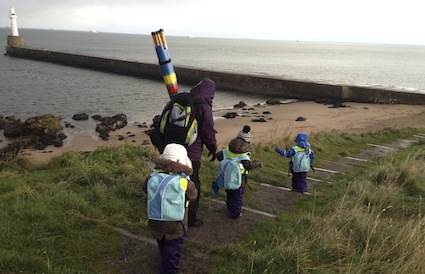
These steps have provided opportunities that I never imagined. This is because I had never really fully considered their affordances. For a concise explanation of affordances and further links, a good starting point is Tim Gill’s blog post. However hopefully my illustration below shows how children benefit from open-ended structures and features which were not designed for learning or play. Yet because they choose to use the steps in a multitude of ways, they become a key part of the beach experience.
In the photo above, the children are going to the beach for the first time. They treat the steps like I had presumed – they are a bit too big to step down, so the children jumped down them instead.
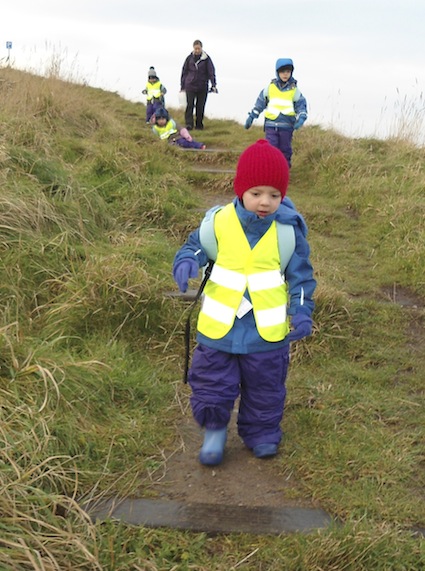
Occasionally children fall down, and have learned that it is up to them to pick themselves back up and keep going. Adults will not assist unless absolutely necessary or asked.
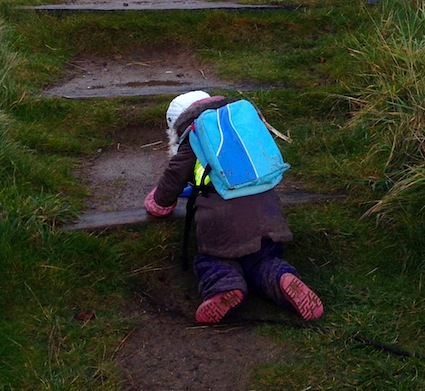
The real challenge comes at the end of the session. The children are tired, there’s a lot of steps to climb and they are big – at least knee or thigh-high!

The children have been quite amazing at this point. Firstly not one child has ever given up or moaned about the journey back up the steps. They get on with it.
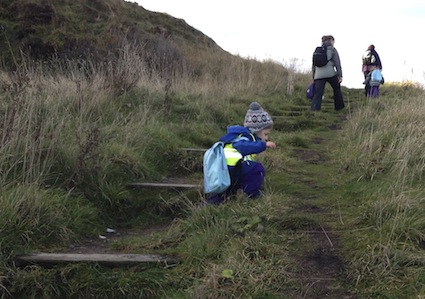
Second, they have found ways to manage the steps. Not least, they have worked out that the path to the side is less work and effort on the way back up. So most end up on the informal side track.
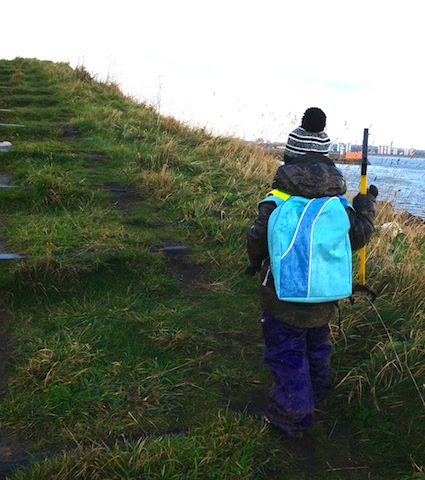
There is no pressure to hurry back up the steps. The children take the time they need. So when a rest or alternative activity is needed, then it can happen. After all, it’s not every day that puddles form on the steps.

And when a child cares enough to pick up a piece of litter, this sort of act should be acknowledged.

The children also find lots to keep themselves occupied. So before we know it, we’re back at the top of the steps again. In the photo above, the children went one step further to the right and deliberately chose to walk up through the long rough grass.

How the children use the steps has changed my own perceptions. The possibilities of big wide steps are huge. Generally in outdoor spaces for little children we want child-sized steps not giant-sized ones. But the play value and level of challenge afforded by these big steps has become apparent. The children have appreciated the alternative choices of the side path. How often do we give children a side path or alternative form of travel?
The beauty of this, is that we can tuck away observations like these. When planning changes to outdoor spaces, we can then use such observations to inform the design and provide a more creative outdoor space.
We can also be more savvy about how we back link these experiences to the curriculum. Suddenly I’m regarding these steps as a key element of the children’s opportunities for physical development which I had not fully realised: jumping and hopping down the steps, crawling, stepping, crouching, bending, moving through rough grass, negotiating the range of different surfaces and uneven terrain. Suddenly the PE experiences and outcomes have been brought to life by these children playing and exploring the steps in their own way. As a teacher, once again, my eyes and mind have been refreshed by what I have witnessed.




















Great to see. Long may it continue!
Thanks and agreed – the challenge is to ensure sustainability!
This is such a great experience for these children & will have positive repercussions for years to come I’m sure. In one of our off site places there is a giant picnic table, think it was meant to be sunk into the ground but it has provided such a challenge for the children to get up on it & off again.
Oooh – I feel a blog post coming on about the need for young children to experience oversized objects!
What a wonderful study of use. Thank you for the link within to Tim Gill’s affordances post. Bookmarking both for future reference!
Yes – Tim writes a lot of useful, relevant material for educators. For me, he will go down as one of the people who has done huge amounts to move society’s thinking around risk and other childhood issues.
Aaah, these pics remind me so much of when my eldest was 2 and we went on holiday to Guernsey. Every time he climbed the steps up from the beach he would say “Up, Up! Well done Zac!” to himself on each step. Great adventures! #CountryKids
Oh Daisy – what a lovely story. Thanks for sharing.
This post demonstrates how vital it is to provide opportunities for children to explore their own capabilities, not just physically but mentally too which helps with their overall development. Thanks for linking up and sharing their outdoor challenge with Country Kids.
Hi Juliet,
I was at the Aberdeen Learning Festival today and saw a lovely display of photos of children out for a wee play at the beach. I hear it’s called the Wee Green Project. Where can I find out more about this?
Katie
Hi Katie – Contact the Early Years team – Fiona Thomson.
You can read the beach blog posts here! This is the 4th one.
I’m planning to get an information sheet created in the next few weeks too. I’ll let you know when it’s ready to share.